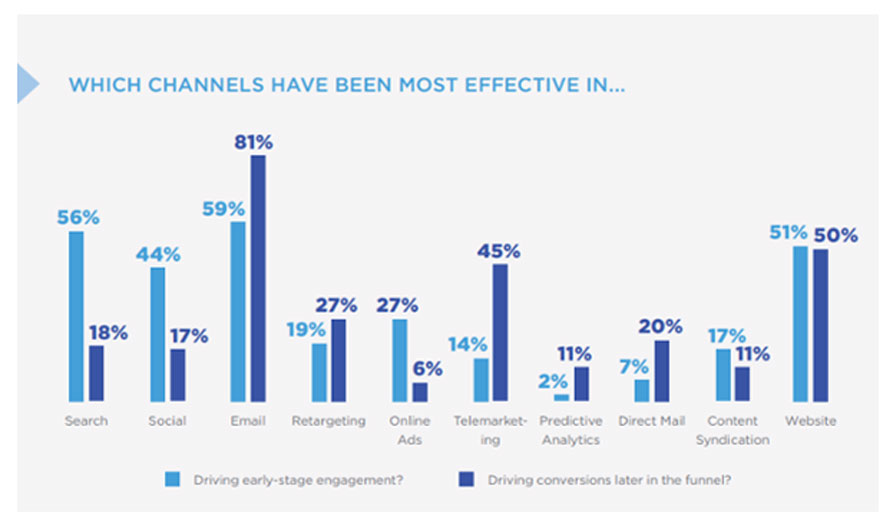Top 5 Digital Demand Generation Channels – Are You Online Yet?

Top 5 Digital Demand Generation Channels – Are You Online Yet?
According to survey results published in the DemandGen’s 2018 Benchmark Survey Report 8 out of 10 channels most effective in driving “early-stage engagement” and “conversions later in the funnel,” were digital.
In-person events continue to be effective and are considered successful channels for engaging prospects throughout the entire funnel. However, the shift to digital has been underway for more than a decade.
Let’s look at the top 5 Digital Channels and their impact in driving early stage engagement and late stage conversions and what one needs to consider when deploying them.
#1. Email
Email marketing is the number one channel for B2B demand generation. In the Benchmark Report, 59% stated that email was most effective in driving early-stage engagement, while a massive 81% indicated that it was most effective in driving late-funnel conversions.
Impact: The result means that email is the most effective channel through the complete stages of the funnel.
Things to consider: An email marketing campaign has to be part of the repertoire for all service providers and some best practices that need to be followed include permissions, great engaging content, target segmentation and ensuring content differentiation and frequency.
#2: Search
Search continues to be most effective (56%) at early stage engagement when prospective customers are looking to gain knowledge about solutions that they can use to solve problems, B2B organizations provide content to solve those problems. It’s not so effective (18%) at late stages of the sales cycle – when customers tend to be looking more for value differentiators that can aid their decision making.
Impact: The result means that search can be effectively used by service providers and brands to introduce themselves and be part of the consideration set of buyers who are beginning their process of scouting for solutions to their problems.
Things to consider: Search is clearly an indispensable tool for branding and awareness and hence it is essential that one appears around the top of the search results. Hence SEO and PPC should be top of the best practices. Tracking relevant SEO metrics and ensuring proper keywords and phrases that target audiences use for search must be clearly enumerated.
#3: Website
The ubiquitous website appears as the third most effective channel, both for early stage engagement (51%) as well as for late stage conversions (50%) according to the results from the Benchmark Report.
Impact: Having a web presence is an absolute necessity. It is therefore incumbent on us to provide visitors with a great experience, so that they take the time to spend quality time knowing you and exploring your offerings.
Things to consider: Website design is a deliberate process. Apart from the obvious considerations viz. purpose, provision of information, security etc.one needs to consider that it is creative, responsive, SEO friendly, easily navigable, multi-browser compatible and has social media integration etc.
#4: Social
Social follows search in similarity as far as effectiveness is concerned with 44% at early stage engagement as compared to 17% at late stage as per the results from the Benchmark Report.
Impact: Prospective customers need to be engaged where they’re present and relevant to one’s industry. Be it Facebook. Twitter, LinkedIn, Pinterest, Snapchat or Instagram to name a few.
Things to consider: Every social channel has its share of audience and most of them have across different platform. Identifying your target segment and engaging them with the right conversations, content, interactive elements etc and in a coherent manner. Requires research, analytics and production abilities that may not be necessarily available in-house.
#5: Online Ads
Rounding up the top 5, per the Benchmark survey, online ads (or display ads) come in as being most effective (27%) at early-stage engagement and comparatively negligible (6%) for late-stage conversions.
Impact: The PPC or pay-per-click is still relevant today and can be effectively used as a means to present oneself in front of target audiences and be part of their consideration set when they are scouting for solutions to their problems.
Things to consider: Clear defined objectives, knowledge about your target audience, a well-defined campaign strategy, CTAs, metrics tracking are an important factors. Identifying the best platforms (Facebook, Twitter, LinkedIn etc.) defining budgets and a scalable approach can contribute further to your success.
It’s easy to get confused when establishing a digital demand strategy for your business. Obviously one cannot rely on a single digital channel to generate the results you want. There are always pros and cons that one needs to consider specific to one’s goals, business as well as target audiences. What channels will drive results in the shortest time or the highest ROI requires thoughtful consideration. The DemandGen Benchmark Report provides some perspective.
It also however comes down to the available talent and the budget that you have.
